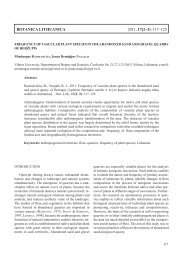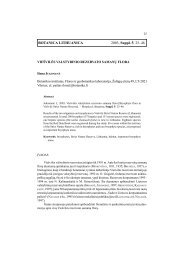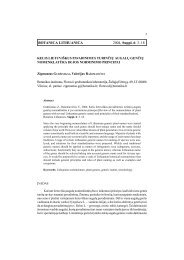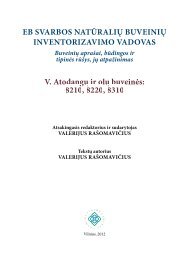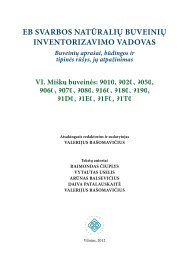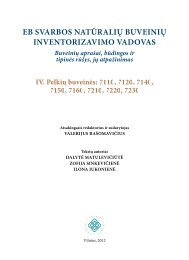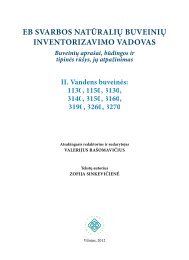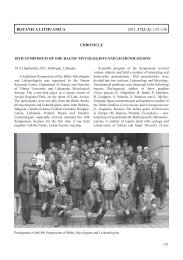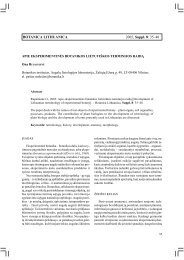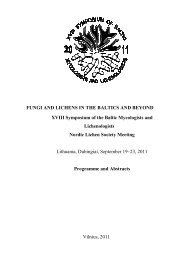Botanica Lithuanica 2011, 17(4): 185–187
Botanica Lithuanica 2011, 17(4): 185–187
Botanica Lithuanica 2011, 17(4): 185–187
Create successful ePaper yourself
Turn your PDF publications into a flip-book with our unique Google optimized e-Paper software.
<strong>Botanica</strong> <strong>Lithuanica</strong> <strong>2011</strong>, <strong>17</strong>(4): <strong>185–187</strong><br />
Short notes<br />
Trumpi pranešimai<br />
UNUSUAL VEGETATIVE PROPAGATION OF Water lobelia (LOBELIA DORTMANNA)<br />
IN LAKE SALINIS (LITHUANIA)<br />
Jurgita Makavičiūtė, Zofija Sinkevičienė<br />
Nature Research Centre, Institute of Botany, Žaliųjų Ežerų Str. 49, LT-08406 Vilnius, Lithuania;<br />
e-mail: jurgita.makaviciute@botanika.lt<br />
Abstract<br />
Makavičiūtė J., Sinkevičienė Z., <strong>2011</strong>: Unusual vegetative propagation of water lobelia (Lobelia<br />
dortmanna) in Lake Salinis (Lithuania). [Neįprastas ežerinės lobelijos (Lobelia dortmanna)<br />
vegetatyvinio dauginimosi atvejis Salinio ežere Lietuvoje]. – Both. Lith., <strong>17</strong>(4): <strong>185–187</strong>.<br />
Unusual vegetatively propagating individual of Lobelia dortmanna L. was found in summer 2009<br />
during the studies of the plant population in Lake Salinis (Lithuania). The young vegetative plant<br />
consisting of two leaves and abundant roots was located on old inflorescence stem at a distance of<br />
2.5 cm above the base. No other reports about the same or similar mode of vegetative propagation<br />
are known for this species.<br />
Keywords: vegetative propagation, submerged plants, isoetid, Lobelia dortmanna, Lake Salinis.<br />
Propagation predominantly by generative mode is<br />
an exception among aquatic plants. Though generative<br />
propagation is more important than vegetative propagation<br />
for survival and renewal of Lobelia dortmanna<br />
L. – perennial, rosette-forming isoetid species (Farmer,<br />
1989; Szmeja, 1994). Water lobelia has no special organ<br />
for vegetative propagation. New plants are formed from<br />
axillary buds at the base of the old flowering shoots<br />
(Möller, 1978; Farmer, 1989). This type of vegetative<br />
propagation is assumed to occur only after the<br />
first flowering (Aberg, 1943; Farmer & Spence, 1987).<br />
Pseudovivipary (the replacement of generative reproducing<br />
organs by vegetative propagules) as other mode<br />
of vegetative propagation in L. dortmanna has been noticed<br />
in Norway (Smolders et al., 1995).<br />
Lobelia dortmanna, one of rare red-listed plant species<br />
in Lithuania, has recently been recorded only in<br />
four lakes (Sinkevičienė, 2007). Generative plants with<br />
flowers and mature seed capsules are common in Lithuanian<br />
populations of L. dortmanna (Makavičiūtė &<br />
Sinkevičienė, 2010), however, vegetative propagation<br />
has not been observed until now.<br />
Vegetatively propagating L. dortmanna was accidentally<br />
found for the first time on 27 July 2009 in Lake<br />
Salinis (Švenčionys distr., 55° 13′ 8″ N, 25° 57′ 49″ E)<br />
during the plant population studies. The mother plant<br />
was found at a depth of 0.8 m rooted in organic silt.<br />
Rosette of generative individual was cut by sampling<br />
frame. Young vegetative plant situated on inflorescence<br />
stem at a distance of 2.5 cm above the base was clearly<br />
185
Fig. 1. Vegetatively propagating specimen of Lobelia dortmanna from Lake Salinis (Lithuania).<br />
visible (Fig. 1). The upper part of stem was withered<br />
away. New plant consisted of two leaves 5.2 and 5.5<br />
cm in length and quite abundant roots. The length of<br />
mother individual leaves varied from 3.5 to 5.9 cm, the<br />
average length (mean ± SD) was 4.72 ± 0.72 cm.<br />
Special search of vegetatively propagating individuals<br />
has not been performed and no other individuals<br />
found. As far as we know, the same or similar mode of<br />
vegetative propagation of L. dortmanna has not been<br />
described. Supposedly, the vegetative propagation of L.<br />
dortmanna could be induced by environmental conditions.<br />
Very shallow (average depth < 3 m) and small<br />
(area 5.43 ha) Lake Salinis is surrounded by arable fields<br />
and pastures of the neighbouring village. Recently the<br />
lake has been intensively used for recreation. Sharply<br />
deepening slope of the lake along a coast is occupied<br />
by helophytes (e.g. Acorus calamus L., Carex rostrata<br />
Stokes, Lysimachia thyrsiflora L.) that create a shading<br />
for Lobelia dortmanna and likely reduce possibilities<br />
for flowering. Although sand dominates at the bottom<br />
of the lake, lobelia’s distribution area is covered with a<br />
layer of sludge up to 30 cm in the shallowest part. The<br />
inundation in the sediments could be the main reason<br />
for the formation of young plant below the base of the<br />
flowering shoot, below or at the level of sediments surface.<br />
In general, any processes related with the natural<br />
and anthropogenic eutrophication in the lake probably<br />
could stimulate vegetative propagation of lobelia. Currently,<br />
it is unclear whether such or any other mode of<br />
vegetative propagation is very rare or whether under<br />
unfavourable for flowering conditions is more frequent<br />
in L. dortmanna populations. However, such studies are<br />
omitted in Lithuania as well as in other countries.<br />
REFERENCES<br />
Aberg B., 1943: Physiologische und ökologische Studien<br />
über die pflanzliche Photomorphose. – Symbolae<br />
<strong>Botanica</strong>e Upsalienses, 8: 1–189.<br />
Farmer A. M., Spence D. H. N., 1987: Flowering, germination<br />
and zonation of the submerged aquatic<br />
plant Lobelia dortmanna L. – Journal of Ecology,<br />
75: 1065–1076.<br />
186
Farmer A. M., 1989: Biological flora of the British<br />
Isles. Lobelia dortmanna L. – Journal of Ecology,<br />
77: 1161–1<strong>17</strong>3.<br />
Makavičiūtė J., Sinkevičienė Z., 2010: Initial data on<br />
populations of water lobelia (Lobelia dortmanna) in<br />
Lithuania. – <strong>Botanica</strong> <strong>Lithuanica</strong>, 16(1): 13–20.<br />
Möller R. E., 1978: Seasonal changes in biomass, tissue<br />
chemistry and net production of the evergreen<br />
hydrophyte Lobelia dortmanna. – Canadian Journal<br />
of Botany, 56: 1425–1433.<br />
Sinkevičienė Z., 2007: Ežerinė lobelija Lobelia dortmanna<br />
L. – In: Rašomavičius V. (ed.), Lietuvos raudonoji<br />
knyga: 5<strong>17</strong>. – Vilnius.<br />
Smolders A., den Hartog C., Roelofs J. G. M., 1995: A<br />
pseudoviviparous specimen of Lobelia dortmanna<br />
L. in Lake Haptatjørn (S. W. Norway). – Aquatic<br />
Botany, 49: 269–271.<br />
Szmeja J., 1994: An individual’s status in populations<br />
of isoetid species. – Aquatic Botany, 48: 203–224.<br />
187
188



